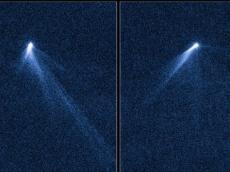|
|
TODAY.AZ / Weird / Interesting
New asteroid that 'belches out dust' discovered
09 November 2013 [12:40] - TODAY.AZ
 What's that in the sky? Is it an asteroid? A comet? A lawn sprinkler?
What's that in the sky? Is it an asteroid? A comet? A lawn sprinkler?Turns out a newly discovered object is a little bit of all three -- minus the fact that you won't find many green lawns millions of miles from Earth -- NASA announced Friday.
"We were literally dumbfounded when we saw it," David Jewitt, who leads the team exploring the "asteroid with six comet-like tails of dust radiating from it like spokes on a wheel."
"It" is P/2013 P5, which NASA described as an "unusually fuzzy-looking object" when it was spotted in August in our solar system's asteroid belt.
The Hubble Space Telescope then focused on it, photographing it first in early September and then again 13 days later. By then, it looked completely different -- as if it had done a 180-degree flip, NASA said.
"Its tail structures change dramatically ... as it belches out dust," Jewitt, a professor at the University of California at Los Angeles, said in a news release. "That also caught us by surprise. It's hard to believe we're looking at an asteroid."
The first-of-its-kind discovery "completely knocked out" astounded astronomers, he added. Perhaps just as exciting is the expectation that this "amazing object (is) almost certainly the first of many to come."
As Jewitt said: "In astronomy, where you find one, you eventually find a whole bunch more."
The giant rock is about 1,400 feet wide and probably reaches surface temperatures of 1,500 degrees Fahrenheit. For that reason, NASA thinks it's made of rock and not ice, like a typical comet is.
The streams of dust were ejected six times between April and September -- something that the NASA team members believe might have been caused by the asteroid spinning so fast that its surface, at times, broke apart.
NASA is still watching P/2013 P5 -- which Jewitt says apparently is a fragment of a bigger asteroid that broke off approximately 200 million years ago -- to figure out exactly why it's doing what it's doing. One theory is that this is one way that asteroids die.
The full findings were published on November 7 in The Astrophysical Journal Letters.
/CNN/
URL: http://www.today.az/news/interesting/128033.html
 Print version
Print version
Views: 1818
Connect with us. Get latest news and updates.
See Also
- 19 February 2025 [22:20]
Visa and Mastercard can return to Russia, but with restrictions - 05 February 2025 [19:41]
Japan plans to negotiate with Trump to increase LNG imports from United States - 23 January 2025 [23:20]
Dubai once again named cleanest city in the world - 06 December 2024 [22:20]
Are scented candles harmful to health? - 23 November 2024 [14:11]
Magnitude 4.5 earthquake hits Azerbaijan's Lachin - 20 November 2024 [23:30]
Launch vehicle with prototype of Starship made its sixth test flight - 27 October 2024 [09:00]
Fuel prices expected to rise in Sweden - 24 October 2024 [19:14]
Turkiye strikes terror targets in Iraq and Syria - 23 October 2024 [23:46]
Kazakhstan supplied almost entire volume of oil planned for 2024 to Germany in 9 months - 23 October 2024 [22:17]
Taiwan reported passage of Chinese Navy aircraft carrier near island
Most Popular
 Evidence of shelling, civilian killings, and hostage-taking presented in court
Evidence of shelling, civilian killings, and hostage-taking presented in court
 China develops world's first brain-like AI
China develops world's first brain-like AI
 Final day of “Baku Water Week” kicks off with strong participation
Final day of “Baku Water Week” kicks off with strong participation
 Samsung SDS expands AI service offerings for enterprise clients
Samsung SDS expands AI service offerings for enterprise clients
 ASCO’s “Mahmud R?himov” sets sail to Aktau after major overhaul
ASCO’s “Mahmud R?himov” sets sail to Aktau after major overhaul
 Calligraphy meets justice in Kayseri as festival exhibition draws art lovers
Calligraphy meets justice in Kayseri as festival exhibition draws art lovers
 Per capita income in Azerbaijan rises as inflation remains moderate
Per capita income in Azerbaijan rises as inflation remains moderate
